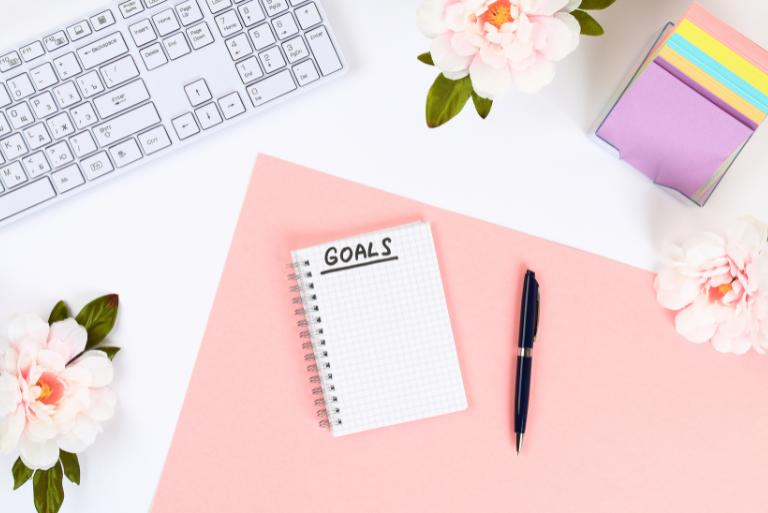This post may contain affiliate links, which means that I may earn a commission if you click on the link, with no cost for you. It’s one of the ways I support my blog. You can read more about this here.
Let’s be honest—having big dreams without a plan is like trying to find a needle in a haystack with your eyes closed. You know what you want to achieve, but without a clear roadmap (i.e. your Personal Development Plan)? You’re just spinning your wheels. Goals are great, but without structure, they’re just dreams. And dreams without action? They stay dreams forever.
So, how do you go from dreaming to doing? You need a personal development plan template that lays out every step you need to take to get from A to B—and guess what? I’ve got you covered.
This post is part of my ‘Change Your Life’ series. The first post in this series is “How to Get Your Life Together in 3 Simple Steps” and I highly recommend you check it out!

What is a Personal Development Plan?
Think of a personal development plan as the blueprint for your life makeover. It’s a roadmap that helps you stay focused, avoid overwhelm, and measure your progress along the way.
It’s like having a GPS for your goals—without it, you’re just wandering around, hoping for the best.
Whether you’re trying to drastically change your life, work on personal growth, or lose 40 pounds, a solid plan is the key to success.
It keeps you on track when life throws curveballs and makes sure you’re always moving forward, even when motivation dips.
Sometimes we need a bit of a reset to rediscover who we really are, and the 30s can be a perfect time for that. If you’re thinking about making some changes, here’s my take on how to reinvent yourself with purpose and joy.
How to Create Your Own Personal Development Plan
Here’s where the magic happens—let’s build your personal development plan step by step.
It’s easier than you think, and once you’ve got it, you’ll feel unstoppable.
1. Set Clear Goals with the IMPACT Framework
First things first, figure out what you want to achieve. Whether it’s improving your health, excelling in your career, or strengthening your relationships, start by setting goals with purpose and direction.
Instead of just creating vague goals like “get fit,” use my IMPACT Goals Framework:
- Intentional: Make sure your goals align with your values and what truly matters to you.
- Measurable: Break down your goal into measurable steps so you can track progress.
- Purpose-driven: Ensure your goals serve a larger purpose in your life, not just short-term results.
- Actionable: Focus on the actions you need to take daily, weekly, or monthly.
- Committed: Stay committed by being consistent and accountable.
- Time-bound: Give yourself a realistic timeline to achieve your goals.
Pin the below for future reference!

For example, instead of saying, “I want to lose 40 pounds,” you could say, “I want to lose 40 pounds by focusing on balanced nutrition, regular exercise, and stress management over the next six months.”
Need a completely fresh start? If you’re ready to reinvent yourself and take control of your life, head over to Reset Your Life: How to Start a Wellness Journey for more tips on making lasting changes.
2. Identify Action Steps: Break Down Your IMPACT Goals
Once you’ve set your IMPACT Goals, the next step is to decompose them into smaller, manageable action steps.
This is where the magic really happens. It’s easy to get overwhelmed by big goals, but when you break them down into specific, actionable steps, they suddenly feel achievable.
Think of your main goal as the “destination” on your roadmap.
The action steps are the pit stops along the way that guide you closer to that destination.
By focusing on one small action at a time, you stay motivated and make consistent progress.
Let’s say your goal is to improve your health. You wouldn’t just say, “I want to be healthier” and leave it at that.

Instead, you would break that big goal down into smaller, more specific steps. For example:
- Week 1: Start by adding more vegetables to your meals.
- Week 2: Begin a simple workout routine, like walking for 30 minutes a day.
- Week 3: Track your water intake and aim to drink 2 litres a day.
- Week 4: Focus on improving your sleep by creating a calming bedtime routine.
By breaking down your larger goal into smaller, achievable steps, you can start building momentum and create sustainable habits over time.
You’ll also feel a sense of accomplishment each time you check off a smaller goal, which will keep you motivated to keep going.
Developing new habits can be challenging, but they’re essential for long-term growth. Head over to How to Create Habits That Stick for practical tips to make your habits last.
Example of Goal Decomposition
Let’s break down a common goal: “I want to lose 40 pounds in six months.”

- Main Goal: Lose 40 pounds by improving diet, increasing exercise, and managing stress.
- Action Step 1: Start meal prepping on Sundays to avoid impulsive eating during the week.
- Action Step 2: Commit to 30 minutes of exercise, five days a week (walking, running, or strength training).
- Action Step 3: Reduce stress by incorporating a 10-minute mindfulness routine daily.
- Action Step 4: Track your progress weekly—whether it’s your weight, fitness improvements, or mood changes.
- Action Step 5: Adjust your routine every month to avoid plateaus and keep things interesting. For instance, switch up your workouts or try new healthy recipes.
The key here is to decompose that main goal into daily, weekly, or monthly actions. This keeps you moving in the right direction without feeling overwhelmed by the bigger picture.
In my upcoming eBook ‘IAGAM Framework’, I cover how to find your strengths and weaknesses which will help you set your action steps.
3. Track Your Progress
Here’s where the accountability comes in. Tracking your progress is key to staying motivated. You can use a simple notebook or a habit tracker app (Or my FREE Notion Template!) to check off your wins and see how far you’ve come.
Trust me, seeing those small victories pile up will keep you going even on tough days.
Pro tip: By using IMPACT Goals, you make your goals much more than just a checklist—they become meaningful, actionable steps that you are fully committed to achieving. It’s how I stayed on track during my own weight loss and personal growth journey!
Key Areas to Focus On
When you’re building your personal development plan, you can choose any area to work on, including:
Health: If improving your health is on the list, set goals around eating better, incorporating joyful movement, or exploring natural sleep remedies to boost your energy.
Career: Looking to make big career moves? Maybe it’s time to get a promotion or switch to a job that aligns with your values. Set clear career goals and build your plan around them.
Relationships: Whether it’s strengthening connections with loved ones or improving your social circle, building strong relationships is a key part of personal growth.
Mindset & Personal Growth: Your mindset is everything. Focus on building a growth mindset that helps you overcome setbacks and keep moving forward.
Download Your Free Personal Development Plan Template
Ready to create your own personal development plan? I’ve put together a collection of free resources from my upcoming IAGAM (Identity, Action, Growth, Achievement Mindset) ebook, designed to walk you through every step of the process.

This template includes key tools and strategies that helped me get my life together—and trust me, they work.
Grab your free template here and start mapping out your goals. Whether you’re aiming to change your life in a year or tackle a 3-month challenge, these resources will help you stay focused, organised, and on track to success.
By signing up you’ll also receive a pretty hefty discount code to use on the eBook when it’s released!)
Final Thoughts
Having a plan is the difference between wishing for change and actually making change happen. It’s what turns your dreams into a reality by giving you clear, actionable steps to follow.
Without a plan, it’s easy to feel lost or overwhelmed, but with the right roadmap in place, you’ll know exactly where to focus your energy and how to adjust when life throws challenges your way.
A well-thought-out plan not only keeps you on track but also builds the confidence and momentum you need to see real, lasting progress.
So, don’t just dream about change—take control, create your plan, and make it happen.
This post is part of my ‘Change Your Life’ series. The next post in this series is “5 Self-Care Activities to Reset Your Life”.
Further Resources
Studies
Personal Development Plans (PDPs) help clarify choices, identify goals, and plan appropriate actions, ultimately improving motivation and personal understanding (Bullock & Jamieson, 1998).
Autonomous goals, which reflect personal values rather than external pressures, result in higher goal progress because individuals are more likely to exert effort and experience less conflict (Koestner et al., 2008).
Specificity in goal-setting, such as detailing how, when, and where to take action, is crucial for goal attainment. The process of writing out personal goals can boost overall performance and well-being, even if the goals span both personal and academic areas (Schippers et al., 2020).
Regular reflection and goal tracking significantly contribute to the success of personal development plans. This not only helps to keep individuals on track but also fosters a sense of accomplishment as progress is made (Patel et al., 2013).
Breaking down major goals into smaller, achievable steps facilitates sustained motivation and avoids overwhelm. This method is proven to enhance goal pursuit and overall performance (Riediger et al., 2005).


